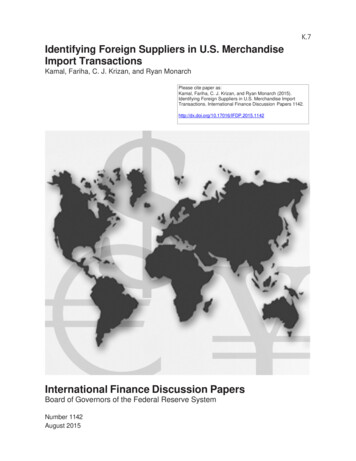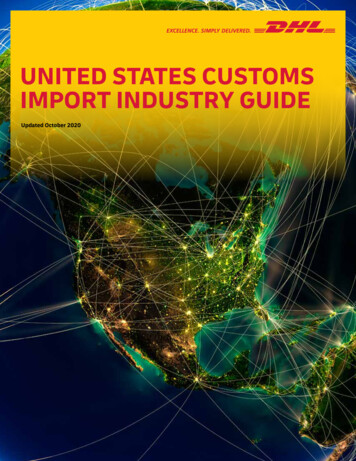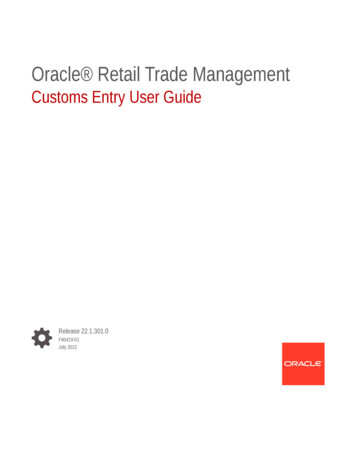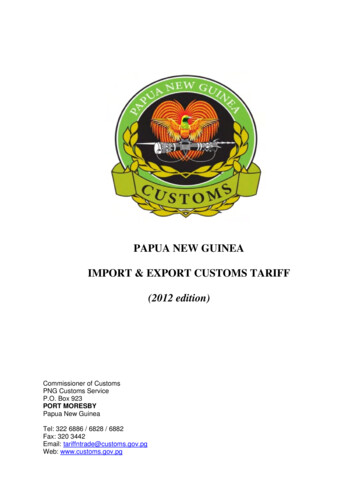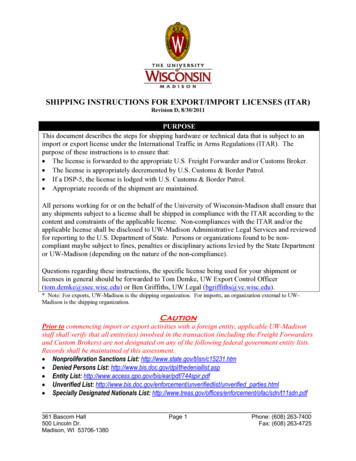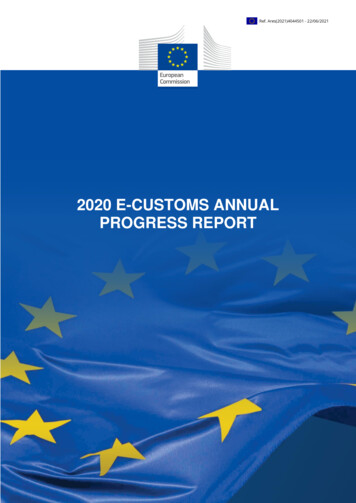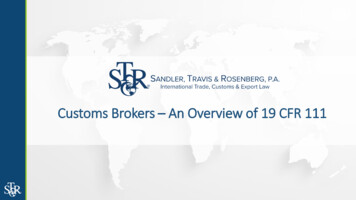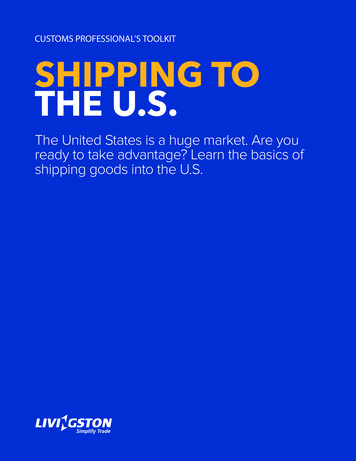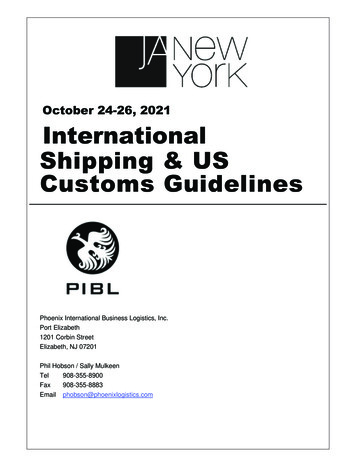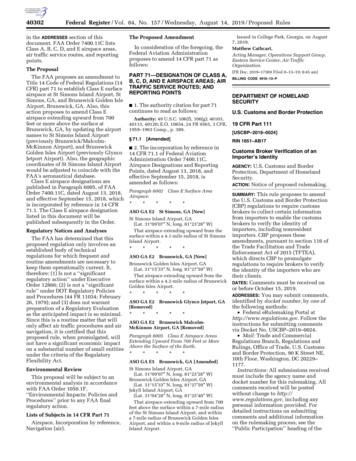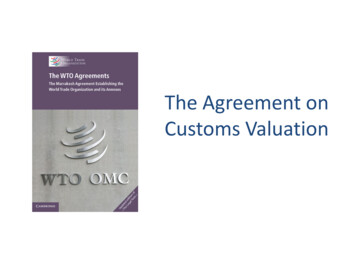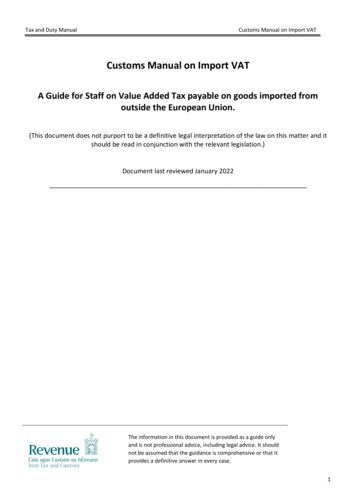
Transcription
Tax and Duty ManualCustoms Manual on Import VATCustoms Manual on Import VATA Guide for Staff on Value Added Tax payable on goods imported fromoutside the European Union.(This document does not purport to be a definitive legal interpretation of the law on this matter and itshould be read in conjunction with the relevant legislation.)Document last reviewed January 2022The information in this document is provided as a guide onlyand is not professional advice, including legal advice. It shouldnot be assumed that the guidance is comprehensive or that itprovides a definitive answer in every case.1
Tax and Duty ManualCustoms Manual on Import VATTable of Contents1Introduction.31.1General .31.2Circumstances giving rise to Import VAT .31.3Import VAT similar to Customs Duty in Operation .51.4Goods from within the European Union.51.5Registered and Unregistered Traders.61.6VAT Rates.62 The Basics of the Import VAT System .62.1AEP / Automated Import System (AIS) .62.2Payment of Import VAT .82.3Value for Import VAT Purposes .92.4Overpayments .112.5Miscellaneous Refund Schemes .133 Relief from Import charges.143.1Reliefs that apply to both Customs Duty & Import VAT .143.2Other Reliefs which only apply to Import VAT .153.3Application of these Reliefs .153.4Relief under temporary admission .163.5The VAT 56A Scheme.163.6Onward Supply Relief (Also known as customs procedure 42 or cp42) .173.7Re-importations.193.8Customs-free airport .203.9Waiver of small amounts.204 Modes of importation .214.1eCommerce .214.2Merchandise in Baggage.214.3Personal travellers .214.4Centralised Clearance .225 Import VAT in specific situations .235.1Aircraft.235.2Ships, boats and other vessels.245.3Clothing.255.4Cinematograph films, sound and video tapes, CD’s and DVD’s.255.5Electronic data.255.6Motor Vehicles .266 Conclusion .276.1Fraud.276.2Doubts and difficulties.28Appendix A - Goods diverted to home use.29Appendix B - Onward Supply Relief .30Appendix C - Legislation .312
Tax and Duty ManualCustoms Manual on Import VAT1 Introduction1.1 GeneralIn accordance with the Value-Added Tax Consolidation Act 2010 VAT is, broadly, payablea)on the supply of goods and services effected within the State for consideration by a taxable personin the course or furtherance of business.b)on the Intra-Community acquisition of goods effected within the State for consideration by ataxable person; andc)on goods imported into the State from outside the European Union.This Manual deals with the situation at (c) above and gives a general overview of the arrangements inplace in relation to VAT payable on goods imported into the State from outside the EU (usually referredto as “Import VAT”). The relevant legislation is contained in Council Directive 2006/112/EC (oftenreferred to as the VAT Directive) and the Value-Added Tax Consolidation Act 2010 (hereinafter referredto as the VAT Consolidation Act) and the Regulations made under that Act. A full list of the relevantlegislation is set out in Appendix C. The detailed circumstances under which Import VAT is payable areset out in the following paragraphs.AIS Changes:Since 23 November 2020 AEP for imports was replaced by Revenue’s Automated Import System (AIS).You will find further information in the Automated Import System (AIS) section on the Revenue website.The majority of import procedures will not change. However, where AIS impacts a procedure it willbe noted in this manual and full details can be found in the AIS trader guide.In AIS, information is contained in 8 Groups, each with its own Data Elements (DE). The reference isexpressed as DE; X/XX. For example, DE 1/1, denotes Group 1, Data element 1.1.2 Circumstances giving rise to Import VAT1.Third Countries and Third Territories - Goods which enter the State from a territory outside theEuropean Union (usually referred to as ‘Third Countries’) are subject to Import VAT. There areseveral places within the European Union which are not governed by the Principal VAT Directiveand imports of goods from these territories may also be subject to Import VAT.These territories are referred to as ‘Third Territories’ or ‘Non-Fiscal Territories’ to distinguish them from‘Third Countries’ and include the following:-Mount Athos-The Canary Islands-The French overseas departments3
Tax and Duty Manual-The Åland Islands-The Channel IslandsCustoms Manual on Import VATIn general, we can say that these territories are part of the Customs Territory of the European Union butnot part of the Fiscal Territory of the European Union. For a complete list of places which do not fallneatly within the Customs Territory or the Fiscal Territory of the EU please refer to Articles 5 to 8 of theVAT Directive.2Imports from the Third Territories are denoted on the import Customs Declaration by the code ‘CO’ inDE 1/1.AIS Data ElementCustoms code1/1CONarrativeImport VAT does not apply to Services.2.Other Member States – As a general rule, EU goods brought into the State from another MemberState are not subject to Import VAT (see paragraph 1.4). However, goods (originally from outsidethe EU) from another Member State which are not in free circulation at the time of their entry tothe State are subject to Import VAT, if they are put into free circulation here. (Typically, this willarise in the context of goods in transit through the other Member State on their way to Ireland).3.Duty Suspension Arrangements - Goods in the State which are held under one of the dutysuspension arrangements listed in paragraph 1.3 below are also subject to Import VAT if they areremoved from the suspension arrangement and placed into free circulation. (This reflects the factthat the Import VAT treatment normally reflects the Customs duty treatment).4.Excise Warehousing - Imports from outside the European Union (other than alcoholic products)which are entered for excise warehousing are subject to Import VAT. In this instance the goods arebeing released for free circulation (i.e. appropriate Customs duty is being paid) and the dutysuspension (warehousing) only applies to the Excise duty. Again, the Import VAT treatmentreflects the Customs duty treatment. (Note: If the goods were being entered for customswarehousing and excise warehousing the Import VAT would not be payable).5.Alcohol - Special rules apply to the payment of VAT on alcohol products when supplied while beingheld under duty suspension arrangements. The effect of these rules is that-Import VAT is not chargeable on imported alcohol products being entered for an excise dutysuspension arrangement (excise warehousing);-instead, the Import VAT due on the importation is payable with the Excise duty on removalof the goods from duty suspension (excise warehouse) and the value for Import VATpurposes includes the Excise duty payable.See Alcohol Products on Revenue.ie for further information.44
Tax and Duty ManualCustoms Manual on Import VAT1.3 Import VAT similar to Customs Duty in OperationThe VAT Consolidation Act provides that the provisions of the Customs Act 20151 and other law in forcein the State relating to customs apply, with such exemptions and modifications as may be specified inRegulations, to Import VAT as if it were a duty of customs. Therefore, the mechanisms for collecting VATon imports generally parallel the arrangements for collecting Customs duty (e.g. the Import VAT iscollected with the Customs duty based on an import declaration). In addition, as a rule, the VATtreatment will follow the Customs duty treatment (e.g. where the goods are placed under a customsregime where Customs duty is not payable (say inward processing) then Import VAT will also not bepayable). However, this is not an absolute rule and there are situations where the Customs and ImportVAT treatment diverges - these differences are outlined in more detail in this Manual.The arrangements where the Import VAT treatment follows the Customs duty treatment are asfollows:43Aa)arrangements for temporary importation with total exemption from Customs duty,b)external transit arrangements,c)temporary storage arrangements,d)customs warehousing arrangements,e)inward processing arrangements,f)arrangements for the admission of goods into territorial waters in connection with drilling orproduction platforms,g)outward processing arrangements.Other arrangements relating to customs concerning the suspension of Customs duties, reduction inCustoms duties or repayment or remission of Customs duties do NOT apply to Import VAT.44 Anexample would be where the goods qualify for non payment of Customs duty because they are for usein a private aircraft - the End-Use Authorisation relieves them of Customs duty, but Import VAT remainspayable. However, an End-use Authorisation to cover goods under paragraph (f) above would relieveboth Customs duty and Import VAT.1.4 Goods from within the European UnionUnion goods brought into the State from other Member States of the EU are still often loosely referredto as “imports”. It should be noted, however, that since the introduction of the Single Market, Uniongoods brought into the State from other Member States are treated in VAT terms as intra-Communityacquisitions and goods supplied to other Member States are treated as intra-Community supplies. ThisManual does not cover these situations, so for further information on supplies of this nature followthe hyperlinks to Revenue.ie.5
Tax and Duty ManualCustoms Manual on Import VAT1.5 Registered and Unregistered TradersTraders are required to register for VAT in certain situations – broadly, if their annual turnover exceeds acertain threshold – see Revenue.ie for further details on the thresholds that apply. Generally, VATregistered traders can claim back, in their VAT Return (VAT 3), the Import VAT paid on goods importedfor their business. Subject to certain exceptions, traders involved in exempt activities and privateindividuals not registered for VAT pay the Import VAT without the possibility of reclaiming it later. Thecircumstances under which unregistered persons can claim a refund of VAT are listed in the VAT sectionof the Revenue website. This is an important distinction and explains why in some instances theapproach to Import VAT will vary depending on whether or not the trader is registered for VAT.See paragraph 2.5 below on Miscellaneous Refund Schemes for further information.1.6 VAT RatesThe rate of Import VAT payable is the same as the rate that applies to supplies of the same (or similar)products in the domestic market. So, goods subject to the zero rate in Ireland will be subject to zero rateon importation, and likewise for goods subject to the reduced or standard rates. Most goods are subjectto the standard VAT rate, as provided for in Section 46(1)(a) of the VAT Act. Those that are not aregoverned by Section 46(1)(b),(c), (ca) and (d) of the Act and the Schedules thereto, which are listedbelow. An index to the VAT rates that apply to a broad range of goods and services is available in theVAT section of the Revenue website. Schedule 1 of the VAT Consolidation Act covers goods which may be Exempt from VAT.10 Schedule 2 of the VAT Consolidation Act11 covers goods which may be zero-rated (0%). Schedule 3 of the VAT Consolidation Act12 covers goods subject to the reduced rates (currently13.5%). Schedule 5 of the VAT Consolidation Act13 covers Works of Art, Collectors’ Items and Antiques alsochargeable at the reduced rate. S. 46(1)(d) of the VAT Consolidation Act provides for the special rate of VAT applicable tolivestock, live greyhounds and the hire of horses (currently 4.8%)Second-hand goods are liable to VAT at the rate applicable to new goods of the same kind. The actualVAT payable will most likely be lower because of the lower second-hand value.Questions concerning liability of goods to VAT and the rates that apply, which cannot be resolvedlocally, should be submitted to VAT Interpretation Branch vat@revenue.ie for ruling.2 The Basics of the Import VAT System2.1 AEP / Automated Import System (AIS)All goods imported to Ireland from outside the European Union must be declared to, and cleared by,Customs. The goods must be declared for free circulation or one of the duty suspensive arrangementslisted in paragraph 1.3 above. Most Customs Declarations are now made by direct trader input (DTI)which involves the entry of the data on an IT system which, currently, is then transmitted electronicallyto customs via the Automated Entry Processing System (AEP).6
Tax and Duty ManualCustoms Manual on Import VATOn 23 November 2020 a new IT system to process Imports was introduced. This new platform is calledAutomated Import System (AIS). More information about AIS may be found here. AIS codes can befound here.The Customs Declaration data, which includes the commodity code of the product, the origin code, thecustoms value etc., enables the AIS, in conjunction with TARIC, to assess the Customs duty payable.Many commodity codes are also linked to the VAT rate which applies to the product and in thesecases, AIS will also calculate the amount of Import VAT payable.The following material is either exempt from or not required to be published under the Freedom ofInformation Act 2014. [ ]Where a system generated VAT rate is not possible, the importer must intervene and declare theappropriate VAT rate by making an entry under DE 6/17 (Commodity code, National additional code)of the Customs Declaration.AIS Data ElementCustoms codeNarrative6/17Commodity codeNational additional codeConsignments consisting of goods subject to different VAT rates must be entered as separate sub-itemswithin the Customs Declaration. The Customs duties payable, along with the Import VAT, are displayedin DE 4/7 (Calculation of Taxes) of the Customs Declaration.AIS Data ElementCustomscodeNarrative4/7B00Import VATImport VAT is indicated by tax type Code B00.The procedure code entered in DE 1/10 (Procedure Code) of the Customs Declaration indicates whetherthe imported goods are being declared for free circulation or one of the duty suspension procedures.The payment of Import VAT on goods entered to any of these procedures is suspended in the samemanner as the duty of Customs and only becomes payable when the goods cease to be held underthose procedures. The arrangements for the payment of duty and the clearance of goods from suchprocedures applies to Import VAT in the same way as it applies to Customs duty. (The Import VATshould be shown separately in the ledger or Home Consumption Warrants and in the MonthlyAccounts.)AIS Data ElementCustoms code1/10Procedure codeNarrative7
Tax and Duty ManualCustoms Manual on Import VAT2.2 Payment of Import VATAIS is integrated with CRS and ITP. This enables the payment of Customs duties and Import VAT,calculated in AIS, to be processed electronically (by deduction from the trader’s bank account) andrecorded on ITP. Import VAT is payable with the Customs duties and the facilities available for makingpayments are the same. Information on the various payment options is available on the Customssection of the Revenue website.Where a doubt/dispute arises as to the correct amount of Import VAT payable, the amount whichappears prima facie to be correct is to be collected. The process setting out how underpayments andoverpayments should be dealt with is set out below.Following the Withdrawal of the UK from the EU on 31 December 2020. A procedure allowing for thepostponement of paying ‘Import VAT’ at the point of entry to the EU became live for VAT registeredbusinesses in Ireland.Those businesses already registered for VAT in Ireland, will be automatically granted this cashflowrelieving procedure called ‘Postponed Accounting’.Postponed Accounting means that the Import VAT is to be accounted for in the next normal VAT 3return of the business using Box T1 and T2(subject to the usual rules regarding entitlement todeductibility) and the completion of a new Box PA1 showing the value of the goods imported. Theseentries will of course be verified in their Annual Return of Trading Details (RTD) form.In order to avail of this procedure, businesses should if using:1.Automated Import System (AIS), place the code 1A05 in data element 2/3 followed by thenarrative ‘IEPOSTPONED’.AIS Data omated Entry Processing System (AEP), place the code 1A01 in Box 44 of the SAD followed bythe narrative ‘IEPOSTPONED’.For further information, please see our weblinks:eCustoms Helpdesk Notification 032/2020 (12/12/2020)VAT – Postponed AccountingAIS codes List is available here8
Tax and Duty ManualCustoms Manual on Import VAT2.3 Value for Import VAT PurposesThe value on which import VAT is assessed is the value for customs purposes plus (CIF value) any Customs/Excise duty or other charges (apart from Import VAT) payable at importation plus the freight costs from the point of import into the EU to the point of import into Ireland.8If the invoice value includes the freight costs to the final point of destination in Ireland, these costswill be included in the value of the consignment and subject to import VAT. If the internal freight costsare unknown at the time of importation, the VAT on this element will be payable as part of the transportservice and thus will not be included with the Import VAT. Further information on the taxation oftransport services is available in the eCustoms area of the Revenue website.Subject to certain exceptions, all consignments in excess of 20,000 require a declaration, at DE2/2(Additional information) of the Customs Declaration, of particulars relating to the customs value ofthe goods being imported. The relevant supporting documentation (including C&E Forms G563 orG563A) should be retained for production to Revenue if and when required. However, a declaration isnot required for importations liable only to Import VAT where:(i)the importer is a person registered for VAT; or(ii)the customs value of the imported goods in a consignment does not exceed 10,000, providedthat they do not constitute split or multiple consignments from the same consignor to the sameconsignee; or(iii)the importations involved are not of a commercial nature.Further information on the valuation of imported goods is available on the Customs section of theRevenue website along with the AIS codes list.AIS Data ElementCustomscodeNarrative / Additional information2/29
Tax and Duty ManualCustoms Manual on Import VATUnderpaymentsUnderpayments of VAT at import arise as a result of the entry of incorrect information on the CustomsDeclaration, either intentional or unintentional. Examples of errors which can give rise to non-paymentor underpayment of import VAT include: use of incorrect TARIC classification codes indicating a lower or zero rate of Customs duty, thusreducing the tax base on which the VAT is levied. use of incorrect Additional Codes indicating a reduced or zero rate of Anti-dumping duty, thusreducing the tax base on which the VAT is levied. incorrect valuation. entering relief codes indicating a relief entitlement for which the product or consignment does notqualify. entering a VAT rate code indicating the reduced or zero rate of VAT where the standard rateapplies. entering a VAT56B code when the trader does not hold a valid VAT-free AuthorisationCorrecting a Customs Declaration – Where an importer discovers a material error in theinformation provided in a previous Customs Declaration, they should submit a correction to theCustoms Declaration without delay. Where this gives rise to an increased liability to Customs dutyor Import VAT the transaction will be referred a customs official for acceptance as a transactionreview work item. Once accepted the underpayment will be processed and collected by AIS in thenormal way.1.Unregistered Persons – Import VAT is treated the same as Customs duty and the procedures fordealing with underpayments are the same. These are as set out in Sections 6 & 11 of the CustomsDebt Manual available on RevNet.2.Registered Persons –Subject to the exceptions described in subsection 4 below, no reassessmentof VAT is to be made after the VAT chargeable on a Customs Declaration has been brought toaccount and the goods have been cleared, where the importer is a registered person. (Theregistered person will only be entitled to claim a credit in their next VAT3 for the actual amount ofImport VAT paid; in this way the underpayment of Import VAT is automatically adjusted through ahigher amount being due with the VAT 3 return.)3.Non-Taxable Activities - An exception to this rule applies where the VAT registered person isengaged in both taxable and non-taxable activities. Examples here would be Banks, StateDepartments, Hospitals, Opticians etc. VAT incurred in respect of non-taxable activities is notdeductible. In the absence of deductibility, the possibility for compensatory adjustments in theregistered person’s next VAT3 does not arise. Underpayments which come to light in these sectorsmust therefore be examined to determine whether they relate to taxable or non-taxable activitiesand any underpayments of Import VAT arising from non-taxable activities should be pursued andbrought to account directly. Where the VAT status of a particular trader or transaction is in doubt,the relevant Division should be consulted.10
Tax and Duty ManualCustoms Manual on Import VATThe following material is either exempt from or not required to be published under the Freedom ofInformation Act 2014.[ ]4.Legislation – Where a registered trader improperly procures the importation of taxable goodswithout the payment of VAT, s/he is liable to a fixed penalty of 4,000 in addition to the taxpayable on the import consignment. This is provided for in S.116(18) of the Value-Added TaxConsolidation Act 2010.2.4 OverpaymentsAs a general rule, and subject to statutory time limits outlined below, where it is discovered by thetrader that the information provided in a previously cleared Customs Declaration was inaccurate, acorrected Customs Declaration must be submitted. This may cause an overpayment to arise.1.Corrections submitted where payment is made from the Trader’s AEP Account - Where thecorrection made to the Customs Declaration results in a reduction in the Import VAT liability theAIS will automatically calculate any overpayment on record. This will trigger a Transaction Reviewwork item and, if approved by the relevant customs official, the amount will be credited to thetrader’s AEP account and will be reflected in the trader’s monthly AEP statement.11
Tax and Duty ManualCustoms Manual on Import VATThe monthly AEP statement takes account of all VAT liabilities and credits for the trader for eachmonth. The net VAT balance shown on this statement (whether it be a debit balance or a creditbalance) is the figure that should be incorporated into the VAT3 return for the trader.2.Corrections submitted where payment is made from the Agent’s AEP Accounta) VAT Registered Clients - Where an agent pays import VAT on behalf of a VAT registered client inerror, the agent should submit the corrected Customs Declaration, and any refund of VAT due onthe original transaction will, once the corrected Customs Declaration is accepted by the relevantcustoms official, be credited to the agent’s AEP account.The agent is then required to issue a credit note (or equivalent) to the importer for the refundedamount in order to ensure that the input credit for the importer’s next VAT3 return will bereduced accordingly.b) VAT Unregistered Clients - Where an agent pays import VAT on behalf of a VAT unregisteredclient in error, the agent should submit the corrected Customs Declaration, and any refund of VATdue on the original transaction will, once the corrected Customs Declaration is accepted by therelevant customs official, be credited to the agent’s AEP account. It is a matter then for the agentto refund this amount to the VAT unregistered client.3.VAT Unregistered Persons - Applications from unregistered persons (where the original non DTIdeclaration was not submitted by an agent) for a refund of Import VAT in respect of returnedgoods, a miscalculation or some other readjustment, should be made to the customs officethrough which the goods were cleared, within four years from the end of the taxable period towhich the claim relates. The procedure for processing such claims is the same as for Customs Dutyand is set out in section 13.8 of the Customs Import Procedures Manual, under the heading‘Repayment and Remission of Import Duties. Information for customers on making refundapplications is available in the Customs section of the Revenue website.4.Overpayment of VAT on Anti-dumping Duty - A VAT refund situation can also arise where, postimportation, the rate of anti-dumping duty is reduced. Typically this would arise where aprovisional anti-dumping duty measure expires without being made definitive, or is madedefinitive at lower rates than the original provisional duty. This gives rise to an overpayment ofAnti-dumping duty and also an overpayment of Import VAT.Pending an update to the AIS to cater for such corrections, the overpayment is to be dealt with byinputting a negative short CI for the amount concerned using the tax type "provisional". (Anegative “short CI” is a mechanism within ITP to create a credit in a trader’s account.) The amountoverpaid will be credited to the payers account in the same way as outlined earlier. The remarksfield of the relevant Customs Declaration should be noted to this effect and the CustomsDeclaration and short CI should be cross-referenced. This is expla
Tax and Duty Manual Customs Manual on Import VAT 5 1.3 Import VAT similar to Customs Duty in Operation The VAT Consolidation Act provides that the provisions of the Customs Act 20151 and other law in force in the State relating to customs apply, with such exemptions and modifications as may be specified in
